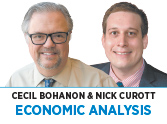Subscriber Benefit
As a subscriber you can listen to articles at work, in the car, or while you work out. Subscribe Now As we see light at the end of the tunnel of our collective COVID nightmare, it is reasonable for economists to examine how the pandemic has changed the organization, production and distribution of goods and services. We find the 1937 insights of the late Nobel-Prize-winning economist Ronald Coase to be very instructive.
As we see light at the end of the tunnel of our collective COVID nightmare, it is reasonable for economists to examine how the pandemic has changed the organization, production and distribution of goods and services. We find the 1937 insights of the late Nobel-Prize-winning economist Ronald Coase to be very instructive.
Coase asked the following question: What parts of the production process are done by the firm that sells the good, and what parts are done by other firms? For example, why does an auto company typically assemble the engine and body of its cars while relying on other firms to make many, if not most, of its cars’ components?
Coase attributed the reason to a simple principle: There are costs and benefits of directing employees to process a good, and there are costs and benefits of using an outside contractor to accomplish the same task. The choice of what is done in-house and what is outsourced depends on a judicious calculation of what is most beneficial to the firm’s bottom line.
Are the results of these cost-benefit calculations set in stone? Absolutely not! Getting it “right” is a matter of inspired insight as well as trial and error. The decision as to what to produce in-house and what to outsource is under constant reappraisal, subject to endless experimentation. While many of those experiments fail, new ways of organizing production are often the source of enormous improvements in productivity.
But more to our theme: Changes in the external environment inevitably change these choices. As we argued back in March 2020, the COVID crisis makes sourcing outside the firm or outside the country more costly. This has been validated by persistent supply-chain interruptions, whether from COVID-related shutdowns from Chinese suppliers or because of transportation interruption from disgruntled Canadian truckers.
But one of the marvelous attributes of a profit-driven system of free enterprise is that a crisis often spawns productive innovation. A recent Wall Street Journal story reported that investment in tech-focused supply-chain companies totaled $24.3 billion in the first nine months of 2021, almost 60% higher than the total for all of 2020. “The companies taking all this investment, and their customers and partners, have come up with a wide variety of strategies for dealing with—or even profiting from—the recent chaos in supply chains,” the story said.
And another marvelous attribute of free enterprise is that this constant but necessary refiguring of the economy cannot be directed by a central national authority. Creative human freedom triumphs. Even during COVID-19.•
__________
Bohanon and Curott are professors of economics at Ball State University. Send comments to [email protected].
Please enable JavaScript to view this content.

Yes, this is a perfect follow up to your last week’s column. To the extent that our current inflation is being driven by supply side interruptions, we can expect businesses to respond to the new set of circumstances and, eventually, fix them. This may take some time. But, if government stays out of the way, inflation will eventually decline. The danger now is that government will react too aggressively with interest rate hikes and/or reductions in spending. The burden of these actions will fall, as they normally do, on those in the bottom half of the income distribution.